Abstract
The potent developmental toxicity of dioxin in multiple species has been known for a number of years. However, recent studies have indicated that dioxin also induces functional developmental defects, many of which are delayed. Subtle structural deficits, not detectable at birth, have also been described in multiple species and in both sexes. Certain defects have been reported not only in animals but also in children prenatally exposed to complex mixtures containing dioxinlike compounds. None of the effects can be attributed to modulation of any one endocrine system. For example, dioxin does not bind to the estrogen receptor, but it can cause effects that are both estrogenic and antiestrogenic. However, viewing dioxin and related compounds as endocrine disruptors that may alter multiple pathways sheds some light on the complexities of this potent class of growth dysregulators.
Full text
PDF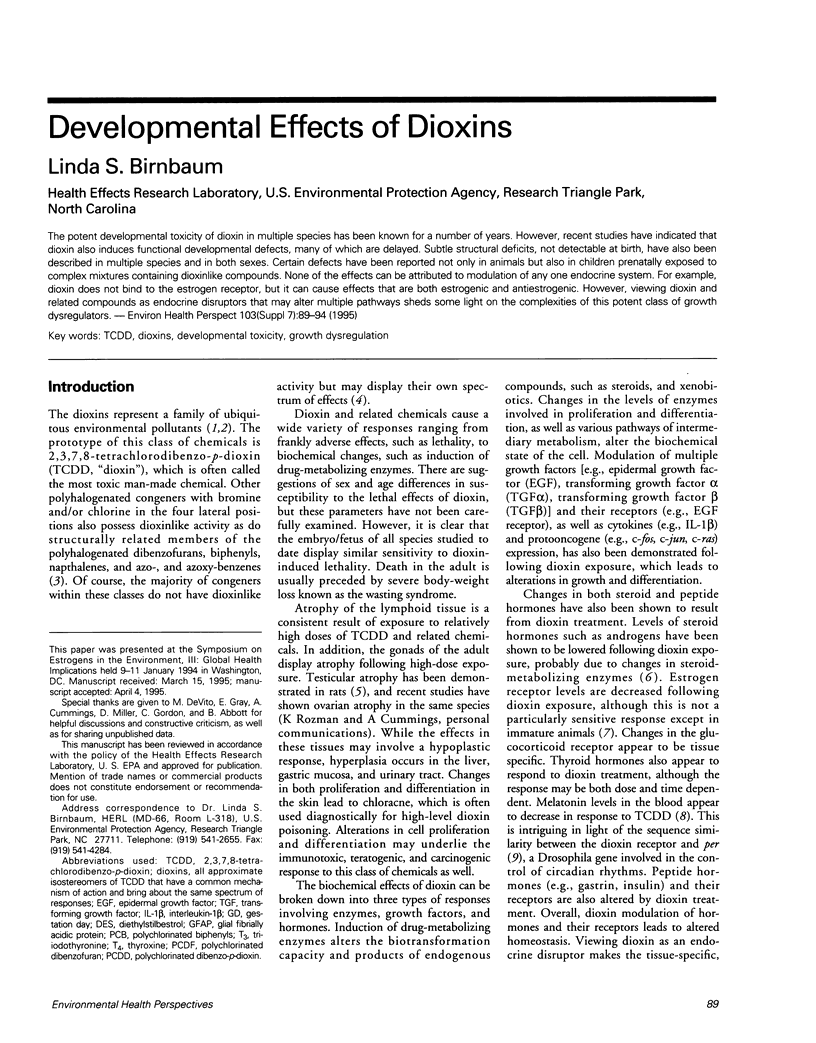
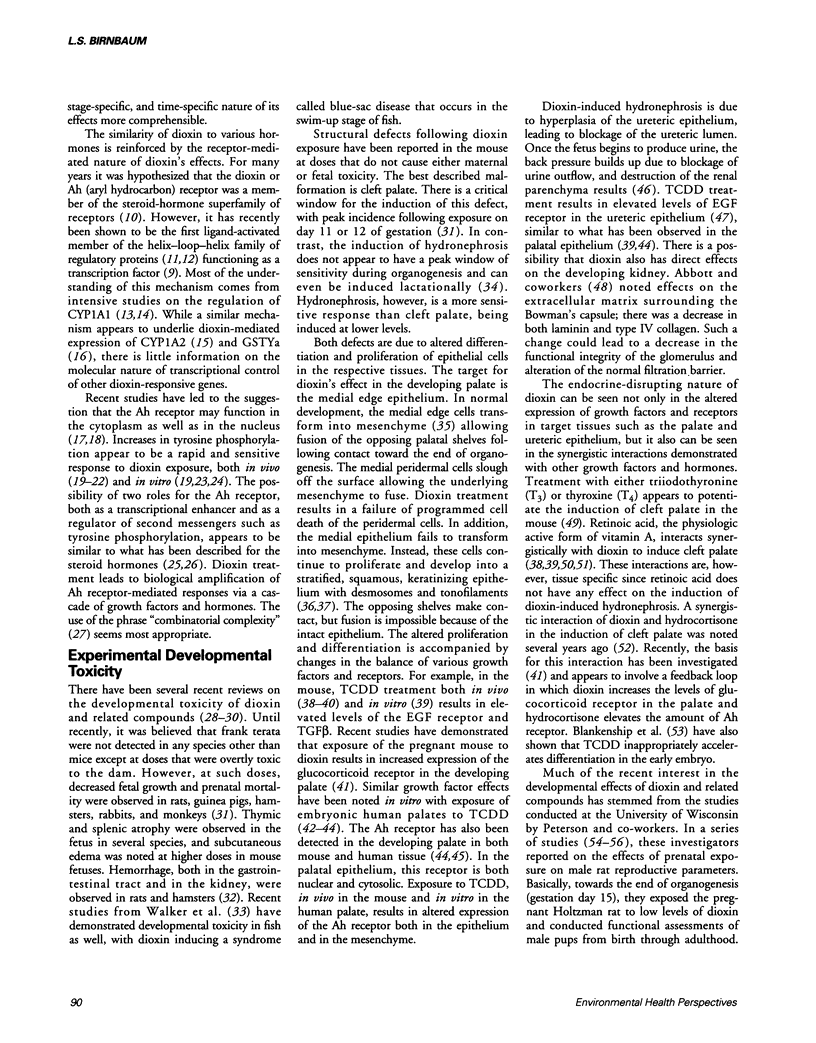
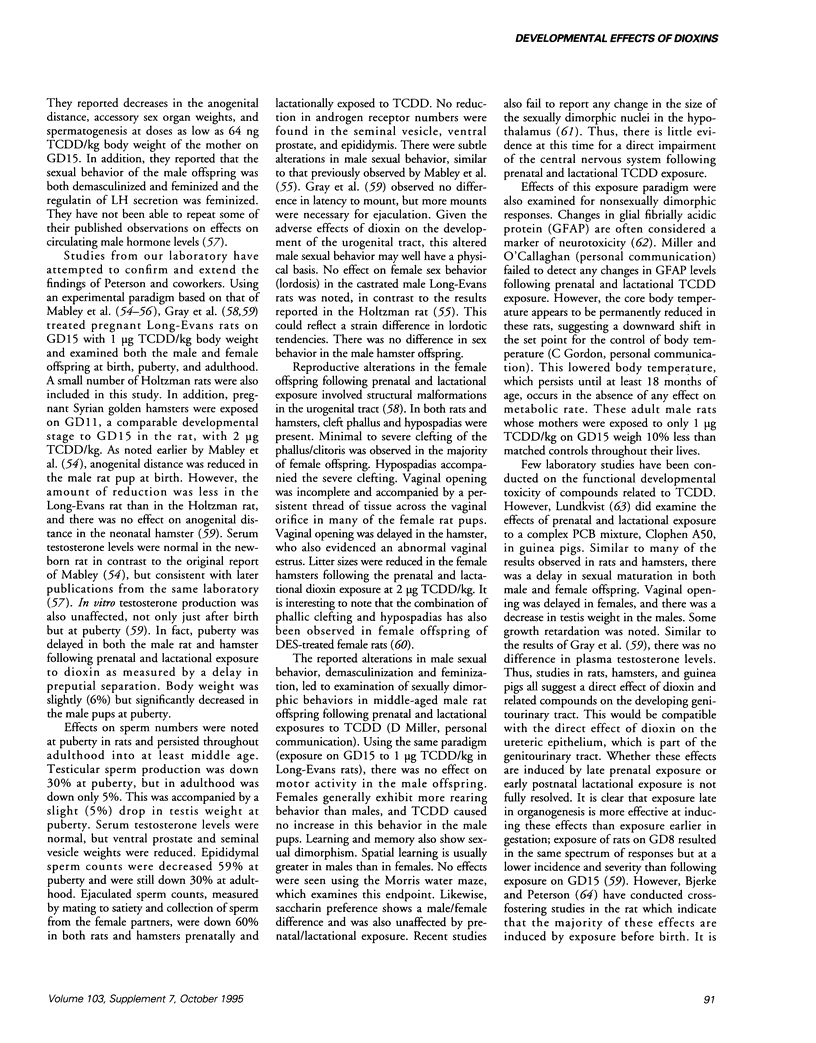
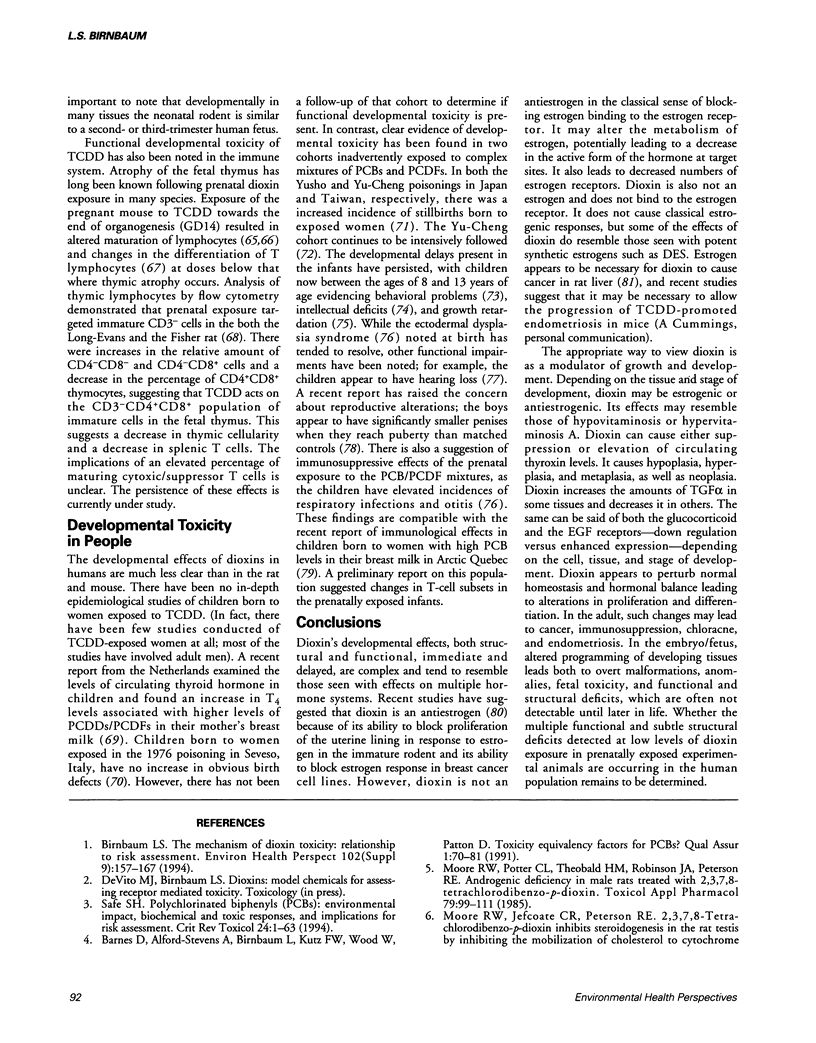
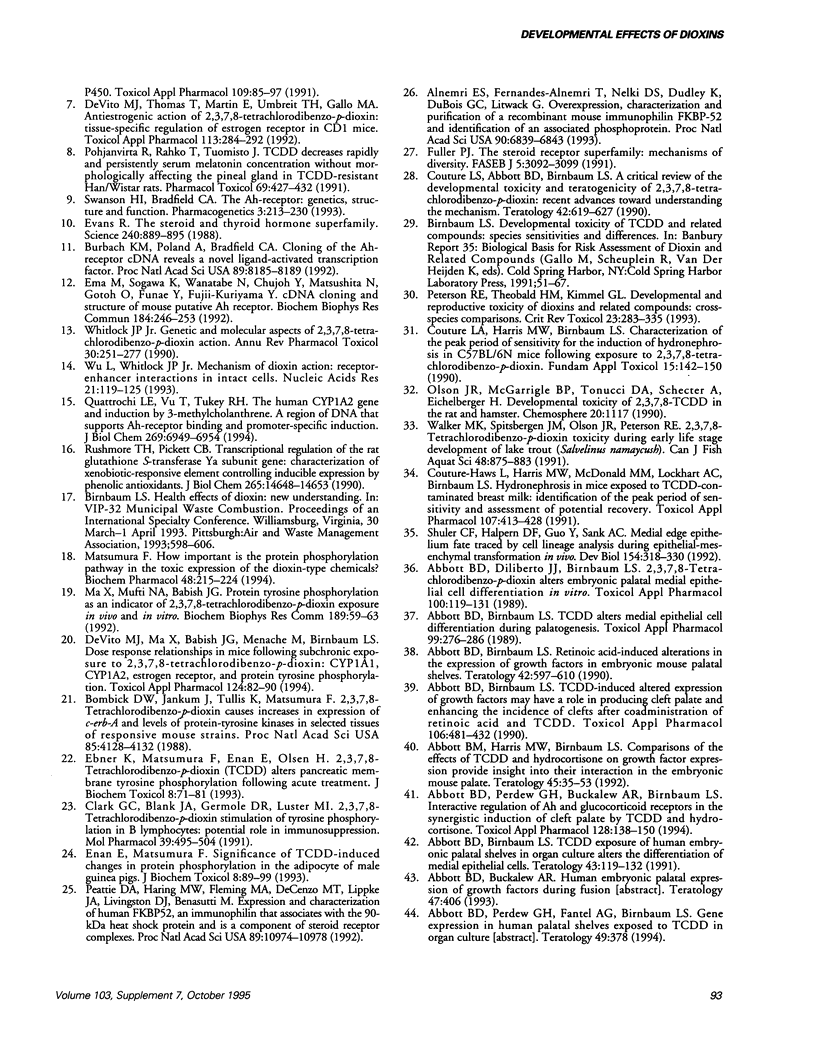
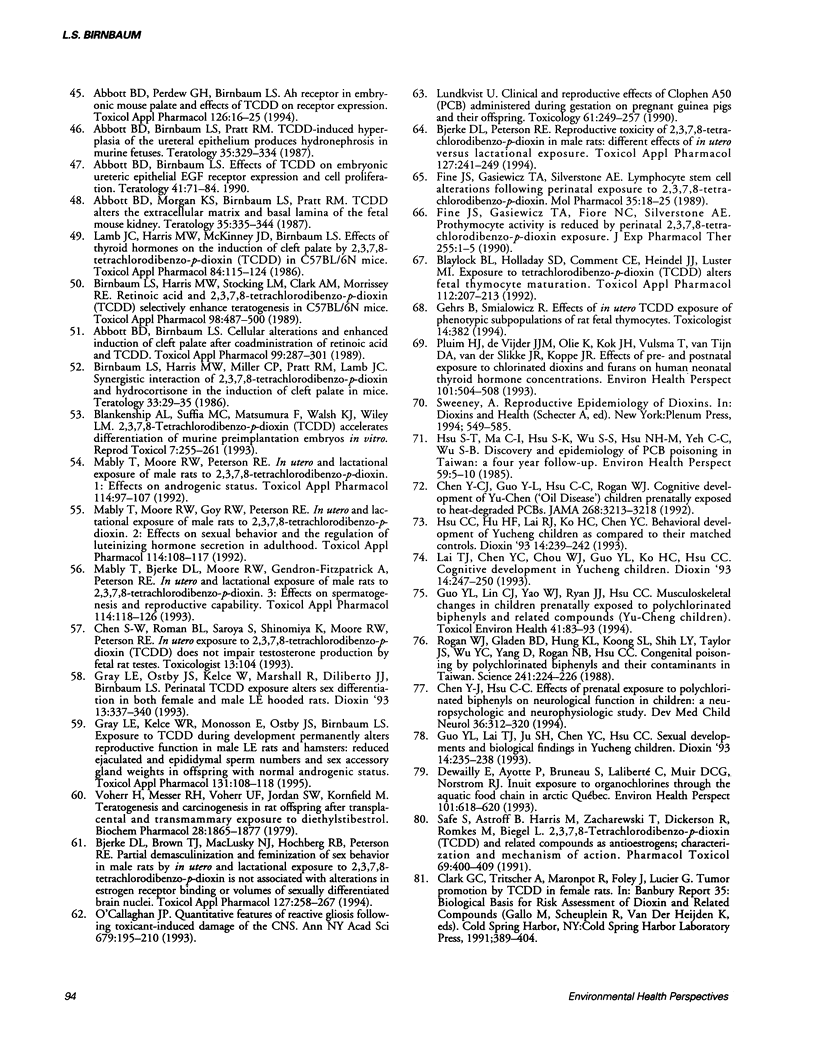
Selected References
These references are in PubMed. This may not be the complete list of references from this article.
- Abbott B. D., Birnbaum L. S. Cellular alterations and enhanced induction of cleft palate after coadministration of retinoic acid and TCDD. Toxicol Appl Pharmacol. 1989 Jun 15;99(2):287–301. doi: 10.1016/0041-008x(89)90011-2. [DOI] [PubMed] [Google Scholar]
- Abbott B. D., Birnbaum L. S. Effects of TCDD on embryonic ureteric epithelial EGF receptor expression and cell proliferation. Teratology. 1990 Jan;41(1):71–84. doi: 10.1002/tera.1420410108. [DOI] [PubMed] [Google Scholar]
- Abbott B. D., Birnbaum L. S., Pratt R. M. TCDD-induced hyperplasia of the ureteral epithelium produces hydronephrosis in murine fetuses. Teratology. 1987 Jun;35(3):329–334. doi: 10.1002/tera.1420350307. [DOI] [PubMed] [Google Scholar]
- Abbott B. D., Birnbaum L. S. Retinoic acid-induced alterations in the expression of growth factors in embryonic mouse palatal shelves. Teratology. 1990 Dec;42(6):597–610. doi: 10.1002/tera.1420420604. [DOI] [PubMed] [Google Scholar]
- Abbott B. D., Birnbaum L. S. TCDD alters medial epithelial cell differentiation during palatogenesis. Toxicol Appl Pharmacol. 1989 Jun 15;99(2):276–286. doi: 10.1016/0041-008x(89)90010-0. [DOI] [PubMed] [Google Scholar]
- Abbott B. D., Birnbaum L. S. TCDD exposure of human embryonic palatal shelves in organ culture alters the differentiation of medial epithelial cells. Teratology. 1991 Feb;43(2):119–132. doi: 10.1002/tera.1420430205. [DOI] [PubMed] [Google Scholar]
- Abbott B. D., Birnbaum L. S. TCDD-induced altered expression of growth factors may have a role in producing cleft palate and enhancing the incidence of clefts after coadministration of retinoic acid and TCDD. Toxicol Appl Pharmacol. 1990 Dec;106(3):418–432. doi: 10.1016/0041-008x(90)90337-t. [DOI] [PubMed] [Google Scholar]
- Abbott B. D., Diliberto J. J., Birnbaum L. S. 2,3,7,8-Tetrachlorodibenzo-p-dioxin alters embryonic palatal medial epithelial cell differentiation in vitro. Toxicol Appl Pharmacol. 1989 Aug;100(1):119–131. doi: 10.1016/0041-008x(89)90096-3. [DOI] [PubMed] [Google Scholar]
- Abbott B. D., Harris M. W., Birnbaum L. S. Comparisons of the effects of TCDD and hydrocortisone on growth factor expression provide insight into their interaction in the embryonic mouse palate. Teratology. 1992 Jan;45(1):35–53. doi: 10.1002/tera.1420450104. [DOI] [PubMed] [Google Scholar]
- Abbott B. D., Morgan K. S., Birnbaum L. S., Pratt R. M. TCDD alters the extracellular matrix and basal lamina of the fetal mouse kidney. Teratology. 1987 Jun;35(3):335–344. doi: 10.1002/tera.1420350308. [DOI] [PubMed] [Google Scholar]
- Abbott B. D., Perdew G. H., Birnbaum L. S. Ah receptor in embryonic mouse palate and effects of TCDD on receptor expression. Toxicol Appl Pharmacol. 1994 May;126(1):16–25. doi: 10.1006/taap.1994.1085. [DOI] [PubMed] [Google Scholar]
- Abbott B. D., Perdew G. H., Buckalew A. R., Birnbaum L. S. Interactive regulation of Ah and glucocorticoid receptors in the synergistic induction of cleft palate by 2,3,7,8-tetrachlorodibenzo-p-dioxin and hydrocortisone. Toxicol Appl Pharmacol. 1994 Sep;128(1):138–150. doi: 10.1006/taap.1994.1191. [DOI] [PubMed] [Google Scholar]
- Alnemri E. S., Fernandes-Alnemri T., Nelki D. S., Dudley K., DuBois G. C., Litwack G. Overexpression, characterization, and purification of a recombinant mouse immunophilin FKBP-52 and identification of an associated phosphoprotein. Proc Natl Acad Sci U S A. 1993 Jul 15;90(14):6839–6843. doi: 10.1073/pnas.90.14.6839. [DOI] [PMC free article] [PubMed] [Google Scholar]
- Barnes D., Alford-Stevens A., Birnbaum L., Kutz F. W., Wood W., Patton D. Toxicity equivalency factors for PCBs? Qual Assur. 1991 Oct;1(1):70–81. [PubMed] [Google Scholar]
- Birnbaum L. S., Harris M. W., Miller C. P., Pratt R. M., Lamb J. C. Synergistic interaction of 2,3,7,8,-tetrachlorodibenzo-p-dioxin and hydrocortisone in the induction of cleft palate in mice. Teratology. 1986 Feb;33(1):29–35. doi: 10.1002/tera.1420330106. [DOI] [PubMed] [Google Scholar]
- Birnbaum L. S., Harris M. W., Stocking L. M., Clark A. M., Morrissey R. E. Retinoic acid and 2,3,7,8-tetrachlorodibenzo-p-dioxin selectively enhance teratogenesis in C57BL/6N mice. Toxicol Appl Pharmacol. 1989 May;98(3):487–500. doi: 10.1016/0041-008x(89)90177-4. [DOI] [PubMed] [Google Scholar]
- Birnbaum L. S. The mechanism of dioxin toxicity: relationship to risk assessment. Environ Health Perspect. 1994 Nov;102 (Suppl 9):157–167. doi: 10.1289/ehp.94102s9157. [DOI] [PMC free article] [PubMed] [Google Scholar]
- Bjerke D. L., Brown T. J., MacLusky N. J., Hochberg R. B., Peterson R. E. Partial demasculinization and feminization of sex behavior in male rats by in utero and lactational exposure to 2,3,7,8-tetrachlorodibenzo-p-dioxin is not associated with alterations in estrogen receptor binding or volumes of sexually differentiated brain nuclei. Toxicol Appl Pharmacol. 1994 Aug;127(2):258–267. doi: 10.1006/taap.1994.1160. [DOI] [PubMed] [Google Scholar]
- Bjerke D. L., Peterson R. E. Reproductive toxicity of 2,3,7,8-tetrachlorodibenzo-p-dioxin in male rats: different effects of in utero versus lactational exposure. Toxicol Appl Pharmacol. 1994 Aug;127(2):241–249. doi: 10.1006/taap.1994.1158. [DOI] [PubMed] [Google Scholar]
- Blankenship A. L., Suffia M. C., Matsumura F., Walsh K. J., Wiley L. M. 2,3,7,8-Tetrachlorodibenzo-p-dioxin (TCDD) accelerates differentiation of murine preimplantation embryos in vitro. Reprod Toxicol. 1993 May-Jun;7(3):255–261. doi: 10.1016/0890-6238(93)90232-v. [DOI] [PubMed] [Google Scholar]
- Blaylock B. L., Holladay S. D., Comment C. E., Heindel J. J., Luster M. I. Exposure to tetrachlorodibenzo-p-dioxin (TCDD) alters fetal thymocyte maturation. Toxicol Appl Pharmacol. 1992 Feb;112(2):207–213. doi: 10.1016/0041-008x(92)90189-y. [DOI] [PubMed] [Google Scholar]
- Bombick D. W., Jankun J., Tullis K., Matsumura F. 2,3,7,8-Tetrachlorodibenzo-p-dioxin causes increases in expression of c-erb-A and levels of protein-tyrosine kinases in selected tissues of responsive mouse strains. Proc Natl Acad Sci U S A. 1988 Jun;85(12):4128–4132. doi: 10.1073/pnas.85.12.4128. [DOI] [PMC free article] [PubMed] [Google Scholar]
- Burbach K. M., Poland A., Bradfield C. A. Cloning of the Ah-receptor cDNA reveals a distinctive ligand-activated transcription factor. Proc Natl Acad Sci U S A. 1992 Sep 1;89(17):8185–8189. doi: 10.1073/pnas.89.17.8185. [DOI] [PMC free article] [PubMed] [Google Scholar]
- Chen Y. C., Guo Y. L., Hsu C. C., Rogan W. J. Cognitive development of Yu-Cheng ("oil disease") children prenatally exposed to heat-degraded PCBs. JAMA. 1992 Dec 9;268(22):3213–3218. [PubMed] [Google Scholar]
- Chen Y. J., Hsu C. C. Effects of prenatal exposure to PCBs on the neurological function of children: a neuropsychological and neurophysiological study. Dev Med Child Neurol. 1994 Apr;36(4):312–320. doi: 10.1111/j.1469-8749.1994.tb11851.x. [DOI] [PubMed] [Google Scholar]
- Clark G. C., Blank J. A., Germolec D. R., Luster M. I. 2,3,7,8-Tetrachlorodibenzo-p-dioxin stimulation of tyrosine phosphorylation in B lymphocytes: potential role in immunosuppression. Mol Pharmacol. 1991 Apr;39(4):495–501. [PubMed] [Google Scholar]
- Couture-Haws L., Harris M. W., McDonald M. M., Lockhart A. C., Birnbaum L. S. Hydronephrosis in mice exposed to TCDD-contaminated breast milk: identification of the peak period of sensitivity and assessment of potential recovery. Toxicol Appl Pharmacol. 1991 Mar 1;107(3):413–428. doi: 10.1016/0041-008x(91)90305-x. [DOI] [PubMed] [Google Scholar]
- Couture L. A., Abbott B. D., Birnbaum L. S. A critical review of the developmental toxicity and teratogenicity of 2,3,7,8-tetrachlorodibenzo-p-dioxin: recent advances toward understanding the mechanism. Teratology. 1990 Dec;42(6):619–627. doi: 10.1002/tera.1420420606. [DOI] [PubMed] [Google Scholar]
- Couture L. A., Harris M. W., Birnbaum L. S. Characterization of the peak period of sensitivity for the induction of hydronephrosis in C57BL/6N mice following exposure to 2,3,7, 8-tetrachlorodibenzo-p-dioxin. Fundam Appl Toxicol. 1990 Jul;15(1):142–150. doi: 10.1016/0272-0590(90)90171-f. [DOI] [PubMed] [Google Scholar]
- DeVito M. J., Ma X., Babish J. G., Menache M., Birnbaum L. S. Dose-response relationships in mice following subchronic exposure to 2,3,7,8-tetrachlorodibenzo-p-dioxin: CYP1A1, CYP1A2, estrogen receptor, and protein tyrosine phosphorylation. Toxicol Appl Pharmacol. 1994 Jan;124(1):82–90. doi: 10.1006/taap.1994.1011. [DOI] [PubMed] [Google Scholar]
- DeVito M. J., Thomas T., Martin E., Umbreit T. H., Gallo M. A. Antiestrogenic action of 2,3,7,8-tetrachlorodibenzo-p-dioxin: tissue-specific regulation of estrogen receptor in CD1 mice. Toxicol Appl Pharmacol. 1992 Apr;113(2):284–292. doi: 10.1016/0041-008x(92)90126-d. [DOI] [PubMed] [Google Scholar]
- Dewailly E., Ayotte P., Bruneau S., Laliberté C., Muir D. C., Norstrom R. J. Inuit exposure to organochlorines through the aquatic food chain in arctic québec. Environ Health Perspect. 1993 Dec;101(7):618–620. doi: 10.1289/ehp.93101618. [DOI] [PMC free article] [PubMed] [Google Scholar]
- Ebner K., Matsumura F., Enan E., Olsen H. 2,3,7,8-Tetrachlorodibenzo-p-dioxin (TCDD) alters pancreatic membrane tyrosine phosphorylation following acute treatment. J Biochem Toxicol. 1993 Jun;8(2):71–81. doi: 10.1002/jbt.2570080204. [DOI] [PubMed] [Google Scholar]
- Ema M., Sogawa K., Watanabe N., Chujoh Y., Matsushita N., Gotoh O., Funae Y., Fujii-Kuriyama Y. cDNA cloning and structure of mouse putative Ah receptor. Biochem Biophys Res Commun. 1992 Apr 15;184(1):246–253. doi: 10.1016/0006-291x(92)91185-s. [DOI] [PubMed] [Google Scholar]
- Enan E., Matsumura F. 2,3,7,8-Tetrachlorodibenzo-P-dioxin induced alterations in protein phosphorylation in guinea pig adipose tissue. J Biochem Toxicol. 1993 Jun;8(2):89–99. doi: 10.1002/jbt.2570080206. [DOI] [PubMed] [Google Scholar]
- Evans R. M. The steroid and thyroid hormone receptor superfamily. Science. 1988 May 13;240(4854):889–895. doi: 10.1126/science.3283939. [DOI] [PMC free article] [PubMed] [Google Scholar]
- Fine J. S., Gasiewicz T. A., Silverstone A. E. Lymphocyte stem cell alterations following perinatal exposure to 2,3,7,8-tetrachlorodibenzo-p-dioxin. Mol Pharmacol. 1989 Jan;35(1):18–25. [PubMed] [Google Scholar]
- Fuller P. J. The steroid receptor superfamily: mechanisms of diversity. FASEB J. 1991 Dec;5(15):3092–3099. doi: 10.1096/fasebj.5.15.1743440. [DOI] [PubMed] [Google Scholar]
- Gray L. E., Jr, Kelce W. R., Monosson E., Ostby J. S., Birnbaum L. S. Exposure to TCDD during development permanently alters reproductive function in male Long Evans rats and hamsters: reduced ejaculated and epididymal sperm numbers and sex accessory gland weights in offspring with normal androgenic status. Toxicol Appl Pharmacol. 1995 Mar;131(1):108–118. doi: 10.1006/taap.1995.1052. [DOI] [PubMed] [Google Scholar]
- Guo Y. L., Lin C. J., Yao W. J., Ryan J. J., Hsu C. C. Musculoskeletal changes in children prenatally exposed to polychlorinated biphenyls and related compounds (Yu-Cheng children). J Toxicol Environ Health. 1994 Jan;41(1):83–93. doi: 10.1080/15287399409531828. [DOI] [PubMed] [Google Scholar]
- Hsu S. T., Ma C. I., Hsu S. K., Wu S. S., Hsu N. H., Yeh C. C., Wu S. B. Discovery and epidemiology of PCB poisoning in Taiwan: a four-year followup. Environ Health Perspect. 1985 Feb;59:5–10. doi: 10.1289/ehp.59-1568088. [DOI] [PMC free article] [PubMed] [Google Scholar]
- Lamb J. C., 4th, Harris M. W., McKinney J. D., Birnbaum L. S. Effects of thyroid hormones on the induction of cleft palate by 2,3,7,8-tetrachlorodibenzo-p-dioxin (TCDD) in C57BL/6N mice. Toxicol Appl Pharmacol. 1986 Jun 15;84(1):115–124. doi: 10.1016/0041-008x(86)90420-5. [DOI] [PubMed] [Google Scholar]
- Linden J., Pohjanvirta R., Rahko T., Tuomisto J. TCDD decreases rapidly and persistently serum melatonin concentration without morphologically affecting the pineal gland in TCDD-resistant Han/Wistar rats. Pharmacol Toxicol. 1991 Dec;69(6):427–432. doi: 10.1111/j.1600-0773.1991.tb01325.x. [DOI] [PubMed] [Google Scholar]
- Lundkvist U. Clinical and reproductive effects of Clophen A50 (PCB) administered during gestation on pregnant guinea pigs and their offspring. Toxicology. 1990 Apr 30;61(3):249–257. doi: 10.1016/0300-483x(90)90175-g. [DOI] [PubMed] [Google Scholar]
- Ma X., Mufti N. A., Babish J. G. Protein tyrosine phosphorylation as an indicator of 2,3,7,8-tetrachloro-p-dioxin exposure in vivo and in vitro. Biochem Biophys Res Commun. 1992 Nov 30;189(1):59–65. doi: 10.1016/0006-291x(92)91525-u. [DOI] [PubMed] [Google Scholar]
- Mably T. A., Bjerke D. L., Moore R. W., Gendron-Fitzpatrick A., Peterson R. E. In utero and lactational exposure of male rats to 2,3,7,8-tetrachlorodibenzo-p-dioxin. 3. Effects on spermatogenesis and reproductive capability. Toxicol Appl Pharmacol. 1992 May;114(1):118–126. doi: 10.1016/0041-008x(92)90103-y. [DOI] [PubMed] [Google Scholar]
- Mably T. A., Moore R. W., Goy R. W., Peterson R. E. In utero and lactational exposure of male rats to 2,3,7,8-tetrachlorodibenzo-p-dioxin. 2. Effects on sexual behavior and the regulation of luteinizing hormone secretion in adulthood. Toxicol Appl Pharmacol. 1992 May;114(1):108–117. doi: 10.1016/0041-008x(92)90102-x. [DOI] [PubMed] [Google Scholar]
- Mably T. A., Moore R. W., Peterson R. E. In utero and lactational exposure of male rats to 2,3,7,8-tetrachlorodibenzo-p-dioxin. 1. Effects on androgenic status. Toxicol Appl Pharmacol. 1992 May;114(1):97–107. doi: 10.1016/0041-008x(92)90101-w. [DOI] [PubMed] [Google Scholar]
- Matsumura F. How important is the protein phosphorylation pathway in the toxic expression of dioxin-type chemicals? Biochem Pharmacol. 1994 Jul 19;48(2):215–224. doi: 10.1016/0006-2952(94)90089-2. [DOI] [PubMed] [Google Scholar]
- Moore R. W., Jefcoate C. R., Peterson R. E. 2,3,7,8-Tetrachlorodibenzo-p-dioxin inhibits steroidogenesis in the rat testis by inhibiting the mobilization of cholesterol to cytochrome P450scc. Toxicol Appl Pharmacol. 1991 Jun 1;109(1):85–97. doi: 10.1016/0041-008x(91)90193-i. [DOI] [PubMed] [Google Scholar]
- Moore R. W., Potter C. L., Theobald H. M., Robinson J. A., Peterson R. E. Androgenic deficiency in male rats treated with 2,3,7,8-tetrachlorodibenzo-p-dioxin. Toxicol Appl Pharmacol. 1985 Jun 15;79(1):99–111. doi: 10.1016/0041-008x(85)90372-2. [DOI] [PubMed] [Google Scholar]
- O'Callaghan J. P. Quantitative features of reactive gliosis following toxicant-induced damage of the CNS. Ann N Y Acad Sci. 1993 May 28;679:195–210. doi: 10.1111/j.1749-6632.1993.tb18299.x. [DOI] [PubMed] [Google Scholar]
- Peattie D. A., Harding M. W., Fleming M. A., DeCenzo M. T., Lippke J. A., Livingston D. J., Benasutti M. Expression and characterization of human FKBP52, an immunophilin that associates with the 90-kDa heat shock protein and is a component of steroid receptor complexes. Proc Natl Acad Sci U S A. 1992 Nov 15;89(22):10974–10978. doi: 10.1073/pnas.89.22.10974. [DOI] [PMC free article] [PubMed] [Google Scholar]
- Peterson R. E., Theobald H. M., Kimmel G. L. Developmental and reproductive toxicity of dioxins and related compounds: cross-species comparisons. Crit Rev Toxicol. 1993;23(3):283–335. doi: 10.3109/10408449309105013. [DOI] [PubMed] [Google Scholar]
- Pluim H. J., de Vijlder J. J., Olie K., Kok J. H., Vulsma T., van Tijn D. A., van der Slikke J. W., Koppe J. G. Effects of pre- and postnatal exposure to chlorinated dioxins and furans on human neonatal thyroid hormone concentrations. Environ Health Perspect. 1993 Nov;101(6):504–508. doi: 10.1289/ehp.93101504. [DOI] [PMC free article] [PubMed] [Google Scholar]
- Quattrochi L. C., Vu T., Tukey R. H. The human CYP1A2 gene and induction by 3-methylcholanthrene. A region of DNA that supports AH-receptor binding and promoter-specific induction. J Biol Chem. 1994 Mar 4;269(9):6949–6954. [PubMed] [Google Scholar]
- Rushmore T. H., Pickett C. B. Transcriptional regulation of the rat glutathione S-transferase Ya subunit gene. Characterization of a xenobiotic-responsive element controlling inducible expression by phenolic antioxidants. J Biol Chem. 1990 Aug 25;265(24):14648–14653. [PubMed] [Google Scholar]
- Safe S., Astroff B., Harris M., Zacharewski T., Dickerson R., Romkes M., Biegel L. 2,3,7,8-Tetrachlorodibenzo-p-dioxin (TCDD) and related compounds as antioestrogens: characterization and mechanism of action. Pharmacol Toxicol. 1991 Dec;69(6):400–409. doi: 10.1111/j.1600-0773.1991.tb01321.x. [DOI] [PubMed] [Google Scholar]
- Shuler C. F., Halpern D. E., Guo Y., Sank A. C. Medial edge epithelium fate traced by cell lineage analysis during epithelial-mesenchymal transformation in vivo. Dev Biol. 1992 Dec;154(2):318–330. doi: 10.1016/0012-1606(92)90071-n. [DOI] [PubMed] [Google Scholar]
- Swanson H. I., Bradfield C. A. The AH-receptor: genetics, structure and function. Pharmacogenetics. 1993 Oct;3(5):213–230. doi: 10.1097/00008571-199310000-00001. [DOI] [PubMed] [Google Scholar]
- Van den Berg M., De Jongh J., Poiger H., Olson J. R. The toxicokinetics and metabolism of polychlorinated dibenzo-p-dioxins (PCDDs) and dibenzofurans (PCDFs) and their relevance for toxicity. Crit Rev Toxicol. 1994;24(1):1–74. doi: 10.3109/10408449409017919. [DOI] [PubMed] [Google Scholar]
- Vorherr H., Messer R. H., Vorherr U. F., Jordan S. W., Kornfeld M. Teratogenesis and carcinogenesis in rat offspring after transplacental and transmammary exposure to diethylstilbestrol. Biochem Pharmacol. 1979 Jun 15;28(12):1865–1877. doi: 10.1016/0006-2952(79)90638-5. [DOI] [PubMed] [Google Scholar]
- Whitlock J. P., Jr Genetic and molecular aspects of 2,3,7,8-tetrachlorodibenzo-p-dioxin action. Annu Rev Pharmacol Toxicol. 1990;30:251–277. doi: 10.1146/annurev.pa.30.040190.001343. [DOI] [PubMed] [Google Scholar]
- Wu L., Whitlock J. P., Jr Mechanism of dioxin action: receptor-enhancer interactions in intact cells. Nucleic Acids Res. 1993 Jan 11;21(1):119–125. doi: 10.1093/nar/21.1.119. [DOI] [PMC free article] [PubMed] [Google Scholar]


